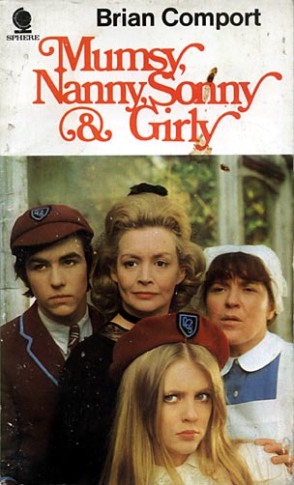
The best thing about Halliwell’s Film Guide is the capsule reviews that read like the work of a disapproving Victorian maiden aunt. The verdict on Mumsy, Nanny, Sonny and Girly is my absolute favourite: “Revolting black comedy for masochists, representing the British cinema at its lowest ebb”. Wow – who wouldn’t watch a film that inspires a write-up like that?
Halliwell’s ideas of what makes for a good British film are obviously very different from mine – and probably yours too as you’re visiting this blog.
Girly (as the title was abbreviated to in the US) is surely one of the most unusual and most entertaining of all British horror films – as well as one of the most thoroughly British. What does that mean? Well, for goodness’ sake, it’s got toasted teacakes and a Sooty doll in it! In short, it’s a film that’s got ‘Cult Classic’ stamped on every frame.
The nightmare of family life is frequently explored in 70s horror films: Girly takes a different tack from most by using the idealised English middle class family and its way of life as a gloriously macabre joke. The family at the centre of this film are psychopaths, yes, but happy psychopaths – because they live by the rules. These rules are handed down by supremely smug matriarch Mumsy (Ursula Howells), who’s aided in enforcing them by the not-terribly-bright Nanny (Pat Heywood). They’re obeyed implicitly by the dear children (actually grown-up, but clad in school uniform with behaviour to match) Sonny and Girly (Howard Trevor and Vanessa Howard). Some of the guests who the children find to bring back to the family’s big house (homeless men and bewildered drunks) are more troublesome, though, and frequent rule-breaking guarantees a trip on the train to see the angels…
The family’s happiness is jeopardised by the arrival of a new friend (Michael Bryant). A drunken reveller picked up by the children, he’s accidentally responsible for the death of his girlfriend (Imogen Hassall, whose elegant beauty’s too much of a contrast to the film’s nursery rhyme world for her to stay around for long) during one of their games, and blackmailed into becoming the family’s new house guest. But he turns out to be far more cunning than previous visitors, and by skilfully twisting the rules to his own ends and exploiting the unspoken tensions behind the family’s jolly façade, he proves just as dangerous as they are.
Bryant’s great as the unwilling guest who eventually realises he can have a lot of fun with the women of the household, seducing them and playing them off against each other (personally I’d have liked to see him have a crack at the fey Sonny as well) – and it could be argued there’s a misogynistic agenda here, the female-dominated family perverted through lack of a father figure and the new friend putting things back to how they should be. But the film’s strongest (and deadliest) character turns out to be Girly. Vanessa Howard’s compelling performance regularly shifts from wide-eyed innocent to naughty schoolgirl to self-assured young woman, and her response to the new friend’s reassurances after he’s taken her virginity (he assumes) is to coldly spit “don’t be so bloody naïve” – a jolting moment that brings the whole nature of what’s really going on in that house into question. It’s never clear quite who has the upper hand in their relationship, and the film’s ending preserves the ambiguity.
Freddie Francis’s career as a director is to say the least a bit uneven, but Girly’s one of its highlights. The film’s scenes of violence are few, but Francis makes those literalising children’s games startling and highly effective (especially the “Tony Chestnut” scene – you’ll see what I mean). I haven’t read Maisie Mosco’s play Happy Family, which the film was based on (I don’t think it’s ever been published in book form) so I don’t know how much the film differs from it (though I’d guess that it ups the violence a bit), but the screenplay by Brian Comport is packed with grim humour, whether his own or Mosco’s.
One of the strangest things about the film is how oddly hip the family’s little world now looks, with its broken dolls and twee Edwardiana (the work of art director Maggie Pinhorn and set decorator Dimity Collins – brilliant names, the pair of them). Mumsy and Girly’s wardrobes both look pretty trendy now as well, and it wouldn’t be a surprise to see either of them swanning around the streets of Brighton (but with a few more tattoos).
No comments:
Post a Comment